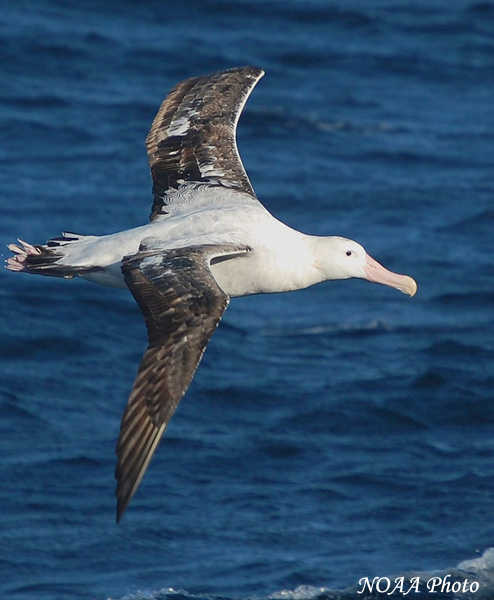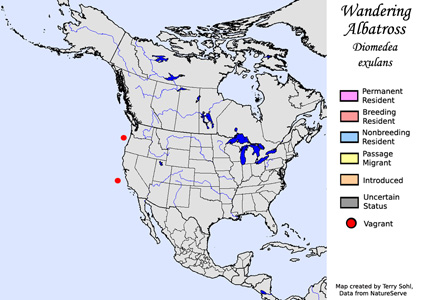| Length: 45 inches | Wingspan: Up to 11 feet | Seasonality: Non-resident in South Dakota |
| ID Keys: Massive size, plumage variable, darker when young and whiter when mature, with completely white underside, head, neck, and back | ||
 The
Wandering Albatross is one of the largest birds in the world, with a
wingspan of up to 11 feet that surpasses all others. Despite their
size, they are truly world-class fliers, and outside of the breeding season,
spend nearly all of their lives in flight. They are very long-lived
birds, with individuals living 50 years or more. Mating pairs stay
together for life. They are normally found on the far southern oceans near
Antarctica and are only an extremely rare visitor to North America, with one
sighting off the coast of Oregon and another off the coast of California (as
of 2012).
The
Wandering Albatross is one of the largest birds in the world, with a
wingspan of up to 11 feet that surpasses all others. Despite their
size, they are truly world-class fliers, and outside of the breeding season,
spend nearly all of their lives in flight. They are very long-lived
birds, with individuals living 50 years or more. Mating pairs stay
together for life. They are normally found on the far southern oceans near
Antarctica and are only an extremely rare visitor to North America, with one
sighting off the coast of Oregon and another off the coast of California (as
of 2012).
Habitat: Breeds on remote islands in the southern oceans. Outside of the breeding season, they can be found wandering across much of the cold oceans of the southern hemisphere.
Diet: Feeds heavily on squid, but will also take fish and crustaceans.
Behavior: Spends nearly its entire life on the wing, outside of the breeding season and when feeding. Feeding is typically done at night, when they often swim on the water and capture squid that come closer to the surface at night.
Nesting: The nest is a large mound built of grasses, mosses, and mud. Pairs typically nest every other year. The female lays a single egg, and both parents will help incubate it during an extremely long incubation period of 2 1/2 months. Upon hatching, both parents will tend to the youngster and help feed it. The young stay with the parents for many months before gaining independence.
Song: Makes a variety of sounds, including grunts, shrieks, and whistles.
Migration: Breeds on islands just near the Antarctic Circle. Outside of the breeding season, they may be found over nearly any cold ocean area in the southern Hemisphere.
Interactive eBird map: Click here to access an interactive eBird map of Wandering Albatross sightings
Similar Species: On the extremely rare occasion that one has been spotted near North America, the typical Northern Hemisphere species they're most likely to be confused with are the Laysan Albatross and the Short-tailed Albatross.
Conservation Status: Longline fishing activities have killed many birds in recent decades, and populations have seriously declined. The IUCN lists the Wandering Albatross as a "Threatened" species.
Further Information: 1) Birdlife.org - Wandering Albatross
2) ARKive.org - Wandering Albatross
3) New Zealand Birds Online - Wandering Albatross
Photo Information: Photo taken by Elizabeth Crapo of the NOAA Corps - Licensed under Creative Commons Attribution 2.0 Generic License.
| Click below for a higher-resolution map |
 |
| South Dakota Status: Non-resident in South Dakota |
Additional Wandering Albatross Photos (coming soon!!)
